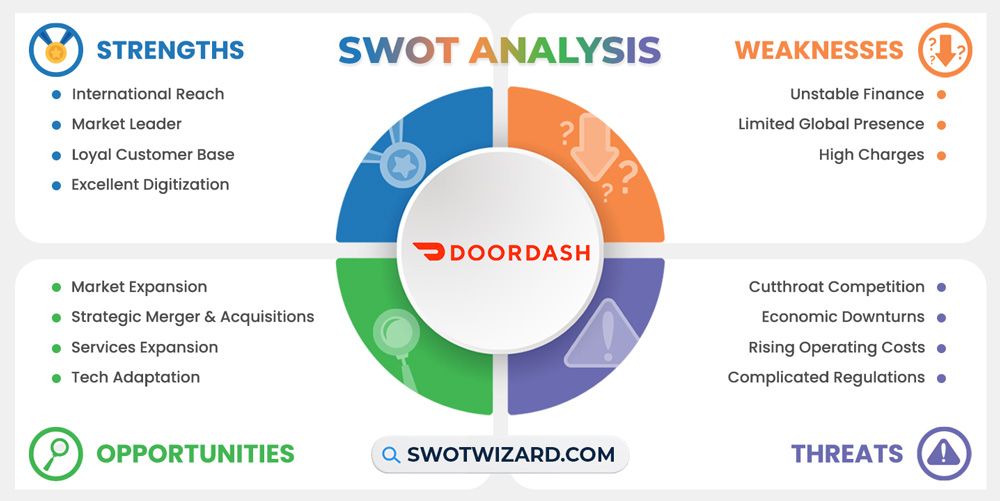DoorDash has a two-thirds market share in the USA, which means millions of people use DoorDash every month and get service. But, within one decade, this much growth was possible because of the right strategy, strengths, overcoming the weaknesses and addressing threats, and capturing the perfect opportunities, which we will get to know in this DoorDash swot analysis.
DoorDash: Company Overview
| Company | DoorDash, Inc. |
| Industry | Online Food Ordering |
| Founded | January, 2013 |
| Founders | Tony Xu, Andy Fang, Stanley Tang, Evan Moore |
| CEO | Tony Xu |
| Headquarter | San Francisco, California, U.S. |
| No. of Employees | 16,800+ |
| Annual Revenue | $6.583 billion (FY 2022) |
| Website | doordash.com |
Founded in 2013 by a trio of enterprising individuals, Tony Xu, Stanley Tang, and Andy Fang, DoorDash began its journey as a small startup driven by a simple vision: to connect people with their favorite local restaurants, bridging the gap between delicious cuisine and the comfort of one’s own home.
Within a decade, the entire landscape changed, and the company has experienced remarkable growth, cementing its position as a leader in the on-demand delivery industry. Today, DoorDash boasts an impressive total revenue of $6.58B with 16,800 employees, a testament to its ability to meet the evolving demands of its ever-expanding customer base.
Product & Services of DoorDash
Food Ordering | Food Delivery
DoorDash Competitors
Uber Eats | Postmates | GrubHub | Seamless | Instacart | Amazon Fresh | Waitr Holdings Inc | FreshDirect | Dumpling | Favor
Did You Know?
Before adopting the name DoorDash, the company operated under “PaloAltoDelivery,” focused solely on serving the Stanford University community, delivering food from local restaurants to students on campus.
Strengths – DoorDash SWOT Analysis

International Reach: With operations in several totals of 27 countries, such as the United States, Canada, and Australia, DoorDash has tapped diverse markets, increasing its revenue potential and establishing a strong international presence, and positioning it as a global player.
Market Leader: In the last five years, DoorDash has suppressed every major competitor in the USA and holds a significant market share in the food delivery industry. According to the data, DoorDash captured approximately 65% of the US food delivery market, also a huge chunk of 34.8% market growth.
Loyal Customer Base: Through targeted marketing, personalized recommendations, and a user-friendly platform, DoorDash has built trust and brand loyalty among its customers, encouraging repeat orders and fostering long-term relationships. As a result, the company has seen this much growth, a value capture.
Excellent Digitization: DoorDash’s robust digital infrastructure and user-friendly app, seamless ordering process, real-time tracking, and efficient customer support systems enhance the user experience and set DoorDash apart from competitors. Besides, their multiple autonomous startups and acquisition have made the operations more efficient.
Weaknesses – DoorDash SWOT Analysis

Unstable Finance: Despite its substantial revenue, DoorDash has faced financial challenges, reporting net losses in recent years. The company incurred a net loss of $-1.365B in 2022. Unstable finances can hinder long-term sustainability and growth potential, requiring strategic financial management and cost optimization measures.
Limited Global Presence: While DoorDash has expanded its operations to Canada and Australia, its international presence remains limited compared to some competitors. DoorDash has yet to establish a significant presence in many countries, missing out on potential market opportunities and leaving room for global competitors to gain a stronger foothold.
High Charges: DoorDash has faced criticism for its pricing structure, which includes delivery fees, service fees, and surge pricing during peak hours. These charges can make ordering through DoorDash more expensive for customers, potentially discouraging frequent usage and leading to customer dissatisfaction.
Opportunities – DoorDash SWOT Analysis

Market Expansion: As the company’s presence is only around 30 countries, there are untapped markets outside the US, such as Europe and Asia, to expand its global presence. Besides, as the purchasing power is increasing in developing countries, competition may be less intense, and it would be easier to capture new customer segments in those countries.
Strategic Merger & Acquisitions: Besides global expansion, the company can also explore opportunities for partnerships and acquisitions. By acquiring smaller regional delivery platforms, DoorDash can gain a foothold in new markets and consolidate its position. Additionally, collaborating with supermarket chains could enable DoorDash to offer grocery delivery services and tap into a lucrative market segment.
Services Expansion: Even though the company started primarily catering to direct customers, as the competition arises, there are opportunities for the company to expand into catering, DoorDash can cater to corporate events, parties, and other large-scale gatherings, increasing its revenue streams.
Tech Adaptation: With more and more techs entering the market, the company can adopt and strategically use them to streamline and efficiently run operations. Besides, Implementing AI algorithms to offer personalized recommendations based on customer preferences can enhance the overall user experience and drive customer loyalty.
Threats – DoorDash SWOT Analysis

Cutthroat Competition: As one of the highest-growth industries, the food delivery industry has become one of the most competitive markets. DoorDash faces fierce competition from other major players like Uber Eats, Grubhub, and Postmates. Even though the company is still the market leader, the old giants, and new players are trying to grab that market share from them.
Economic Downturns: During the COVID-19 pandemic, despite an initial surge in demand, DoorDash experienced a slowdown as unemployment rates rose, impacting consumer purchasing power. Economic uncertainties, recessions, or changes in consumer behavior can pose significant challenges to DoorDash’s growth trajectory.
Rising Operating Costs: As the company expands into new markets, invests in technology, and complies with regulations, managing and mitigating rising operating costs becomes essential to maintaining profitability and financial sustainability. I already mentioned that, despite huge revenue, the company still faces losses because of the rising costs.
Complicated Regulations: Regulations governing food delivery services, labor laws, and licensing requirements can vary across jurisdictions. Several cities have imposed regulations on delivery fees and worker classifications. Compliance with these regulations can be time-consuming and costly, potentially affecting DoorDash’s operations and profitability.
[Bonus Infographic] SWOT Analysis of DoorDash

Recommendations for DoorDash
It’s impressive to grow this fast and become a giant company and market leader in the industry. But, to survive in the long run, they must work harder.
- Prioritize international expansion in countries with a growing food delivery market and favorable regulatory environments.
- Acquire smaller local delivery platforms to expand customer base and restaurant partnerships in specific regions.
- Explore potential mergers or acquisitions to strengthen market position and gain a competitive edge.
- Explore opportunities to provide catering services for corporate clients and large events, tapping into a new market segment.
- Leverage artificial intelligence and machine learning algorithms to optimize delivery routes, reduce delivery times, and enhance efficiency.
Frequently Asked Questions (FAQs)
Who Are The Biggest Investors in DoorDash?
Sequoia Capital Operations LLC is the biggest investor in DoorDash.
What Country Uses DoorDash The Most?
The USA uses DoorDash the most.
Final Words on DoorDash SWOT Analysis
DoorDash has emerged as a trailblazer in the food delivery industry, connecting customers with their favorite local restaurants and satisfying cravings with convenience. Through strategic expansion, international reach, a loyal customer base, technological innovation, and a relentless commitment to customer satisfaction, DoorDash has carved a prominent space in the market.
Despite challenges posed by competition, complicated regulations, economic fluctuations, and operating costs, DoorDash’s adaptability and determination continue to drive its success. With a vision for growth and a dedication to service excellence, DoorDash is poised to shape the future of food delivery for years to come.
References
- Wikipedia contributors. (n.d.). DoorDash. Wikipedia.
- Food Delivery App Revenue and Usage Statistics (2023). (2023, May 24). Business of Apps.
- Gupta, A. (2023, April 26). DoorDash identifies Five big areas for using Generative AI. DoorDash Engineering Blog.
- DoorDash’s (DASH) Growth Slows Down Amid Economic Turmoil. (2022, December 30). Yahoo.





